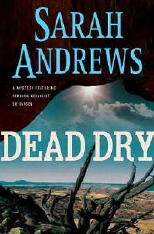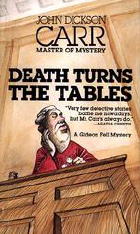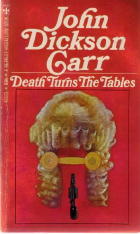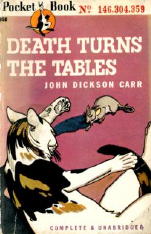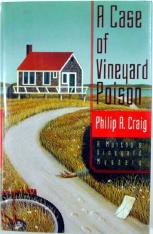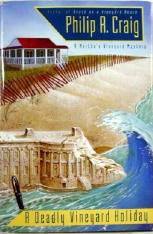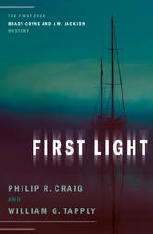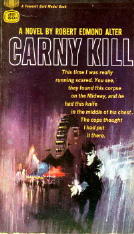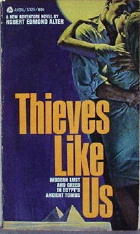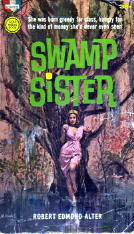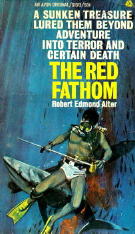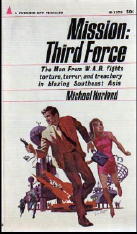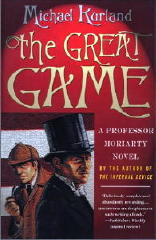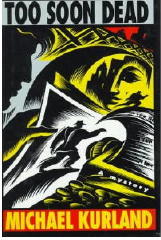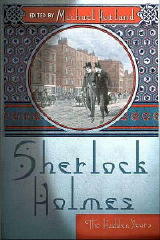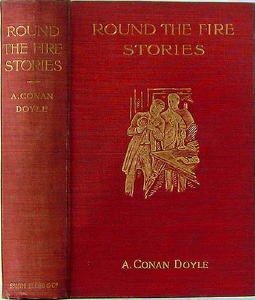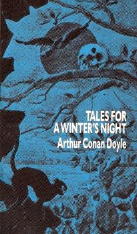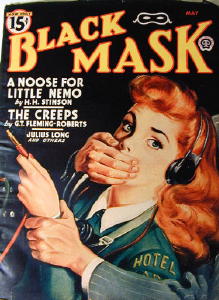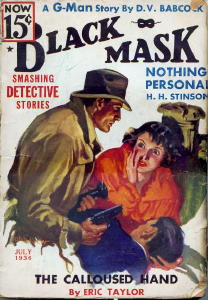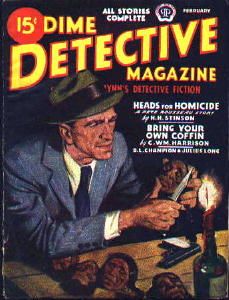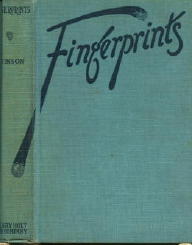May 2007
Monthly Archive
Thu 10 May 2007
SARAH ANDREWS – Dead Dry
St. Martin’s, paperback reprint; 1st printing, September 2006. Hardcover: St. Martin’s Press, November 2005.
Em Hansen, the detective of record in Dead Dry, is the new forensic geologist for the state of Utah, and while she’s had nine previous adventures on record, this is the first case of murder that’s come her way since taking the new position. I’d tell you more about some of her earlier cases, but as it happens, as I so often have to admit, this is the first one of the ten that I’ve happened to read.
For the record, expanded from her entry in Crime Fiction IV, by Allen J. Hubin, here are the previous nine (plus this one, her tenth, along with the one that’s in the works) in chronological order, beginning with her earliest:
Tensleep. Otto Penzler Books, hc, June 1994 [Wyoming]
Signet, pb, December 1995
A Fall in Denver. Scribner, hc, December 1995. [Colorado]
Signet, pb, December 1996
Mother Nature. St. Martin’s, hc, June 1997 [California]
St. Martin’s; pb, July 1998
Only Flesh and Bones. St. Martin’s, hc, May 1998 [Wyoming]
St. Martin’s; ; pb, August 1999
Bone Hunter. St. Martin’s, hc, September 1999 [Utah]
St. Martin’s; pb, September 2000
An Eye for Gold. St. Martin’s, hc, September 2000 [Nevada]
St. Martin’s; pb, Decmber 2001
Fault Line. St. Martin’s, hc, January 2002 [Utah]
St. Martin’s; pb, January 2003
Killer Dust. St. Martin’s, hc, February 2003 [Florida]
St. Martin’s; pb, March 2004
Earth Colors. St. Martin’s, hc, March 2004 [Pennsylvania]
St. Martin’s; pb, December 2004
Dead Dry. St. Martin’s, hc, November 2005 [Utah]
St. Martin’s; pb, September 2006
In Cold Pursuit. St. Martin’s, hc, Spring 2007 [Antarctica]
For a photo of the author is the controls of her plane while researching her latest book, go to her website. You’ll also find a biography of the author there. Short version: “A geologist who writes mystery novels about a geologist.” For the long version, I’ll suggest you simply check out her website. It’s definitely worth a visit.
While researching the publication dates of the books above, mostly on Amazon, I happened to glimpse some of the reviews, and unfortunately, some of them matched my opinion almost completely. Long discourses on matters geological, many of them, too little plot.
In Dead Dry, for example, we (the reader) are given mini-lectures (some not so mini-) on the lack of water in Colorado, along with water resources (and ecology) in general. Not that I’m complaining, mind you, because it’s important, but when it becomes noticeable, as it does here, then maybe (just maybe) it’s overdone, at least in a (mere?) mystery novel.
Which, in the case at hand, involves the death of an old colleague of Em’s, an eccentric geological consultant named Afton McWain, buried in a suspicious quarry wall collapse. Was he the victim of a horrific accident, or is this a case of murder? It is the latter, and the connection with the above-mentioned water resources in Colorado (or lack thereof) has a great deal to do with it.
Besides working all over the western part of the US (see the settings as listed above), Em also seems to have a romantic interest in every book. Whether new ones or not, I do not know, but Fritz (in this one) seems to be rather new, while Ray seems to have been part of her past for some time longer, and it appears that he will stay there.
Now you may have noticed that I have left the detective work involved until after discussing the romantic aspects of the book, mostly because, well, I found the detective work of a rather, um, perfunctory nature. Something invariably seemed lacking. On more than one occasion, I found myself commenting to myself – I almost always write notes to myself while I’m reading – that Em simply wasn’t asking the right questions, if she was asking questions at all.
But she’s a character whose lively, animated outlook on life is definitely worth following – a series wouldn’t last as long as this has if that weren’t true – and it all turns out well in the end. In fact, there is no doubt in my mind that the book is considerably better than the one that I see (looking back) that I have described so far. But (still looking back) I don’t see anything I’ve said that I would change, so I won’t.
— September 2006
Wed 9 May 2007
Posted by Steve under
Authors ,
Reviews1 Comment
JOHN DICKSON CARR – Death Turns the Tables
International Polygonics 330-22; paperback reprint, April 1985. Hardcover editions: Harper & Brothers, 1941. Grosset & Dunlap; n.d; Collier, n.d. British title: The Seat of the Scornful, Hamish Hamilton, 1942. Other US reprint appearances: Two Complete Detective Books, pulp magazine, Fall 1942. Philadelphia Inquirer Sunday supplement, December 5, 1943. Hardcover reprint: Books, Inc., 1946. Paperback reprints: Pocket 350, 1945; Berkley G281, Nov 1959; Berkley F929, 1964; Berkley 1573, 1968.
When it was originally published, the book was sealed after page 193. If the reader were to have read the book to this point and still wished to do so, he could return the book to the bookseller with the seal unbroken and receive a full refund. Since I read the IPL reprint, which has only 156 pages (of small print) in total, I can’t tell you what point in the book that might have been.
[Small pause.] I’ve just checked, and the Harper edition had 256 pages, so the “Challenge to the Reader” seems to have come awfully early. In terms of the relative difficulty in solving the crime before Dr. Gideon Fell does, well, good luck on that. I don’t think that anyone is going figure out all of the details on how, when, where and why the crime is committed, no one, not anyone.
Carr was an absolute master of making his detective fiction so complicated that of course it could never happen in the real world, but once you are in place in his world, it all makes sense, in a fashion and only after the fact. In the early 1940s he was still in peak form, there’s no doubt about it. And here’s a word of advice, if you think that you’re going to give it a shot – figure it out ahead of time, that is – everything that you see (through the detective’s eyes) is going to be important, no matter how trivial it may be. Everything that anyone does is at least 99% going to come back and be important later, I kid you not.
And even so – even so, I say – there were aspects of this work of Mr. Carr, the genius craftsman that he was, that I did figure out ahead of time, but only (I think) because he got there first and they’re clichés of the field now, worn out by overuse by lesser hands.
What’s the story about, you may well ask. I think what I will do this time is to quote the blurb on the back cover. I think it sums things up exceedingly well:
DR. FELL
AND
THE EMINENT
JURIST
Mr. Justice Ireton was a pillar of moral rectitude. Unemotional, he sat godlike upon his bench, and mercilessly handed down the strictest sentences the law allowed.
But then the judge’s future son-in-law was found dead, and although there were plenty of other suspects, even Dr. Fell had to ask:
“Did Mr. Justice Ireton commit murder?”
And here’s a rather lengthy quote, but relevant, I think. Fell and Ireton are playing chess early on in the book (page 17 of the IPL edition):
“Well,” mused Dr. Fell, smoothing his mustache, “that seems to be that. So you couldn’t, for instance, imagine yourself committing a crime?”
The judge reflected.
“Under certain circumstances, I might. Though I doubt it. But if I did –”
“Yes?”
“I should weigh the chances. If they were strongly in my favor, I might take the risk. If they were not in my favor, I should not take it. But one thing I should not do. I should not go off half-cocked, and then whine that I wasn’t guilty and that ‘circumstantial evidence’ was against me. Unfortunately, that’s what they all do – the lot of them.”
“Forgive my curiosity,” said Dr. Fell politely. “But did you ever try an innocent man?”
The answer that Judge Ireton gives is, unfortunately, on the next page, but I submit that it will not necessarily be the answer that you may be suspecting.
The chess game at the beginning is important. It is quite obvious – I believe that it is safe to mention this – that once the dead man is found, Judge Ireton is hiding something. But is he the killer? That is where the real chess match begins.
As always, when you pick up a John Dickson Carr to read, be prepared to be confounded, and it will, I guarantee you, happen once again in Death Turns the Tables. I’m not quite so pleased with the ending, though, as I believe that Dr. Fell concedes on one crucial point far too quickly. That, along with the fact that – and I apologize for not mentioning this before – there is no “locked room,” one of Carr’s best-known specialties, makes this book rate not so highly as it might otherwise have done.
Wed 9 May 2007
Uploaded this afternoon was Part 14 of Allen J. Hubin’s Addenda to the Revised Crime Fiction IV. Most of the data in this installment continues to consist of identifying authors who have entries in the online Contemporary Authors, not previously so noted.
But longer expanded entries are included for a few authors, such as Charles E. Blaney, who specialized in novelizing popular plays at the beginning of last century; and Carola Dunn, who’s currently doing well with her series of Daisy Dalrymple mysteries, but she began her career by writing Regency romances. Many of these early novels had enough criminous elements that they should be included, and given given Carola’s guidance, all of them are.
Recent posts on the M*F blog have resulted in smaller but still significant changes or additions for many other authors, such as Desmond Cory and Charles Runyon. Birth and death dates are continually being discovered, as well as many other facts about mystery writers, both active and not. They’re all included.
Wed 9 May 2007
Posted today on DorothyL:
Date: Tue, 8 May 2007 20:19:03 -0400
From: “William G. Tapply”
Subject: sad news
I am sorry to have to report that my dear friend Philip R. Craig died
today after a short illness. Phil wrote the Martha’s Vineyard series
of mysteries featuring J. W. Jackson, and he and I collaborated on
three novels with J.W. and my Brady Coyne, the third of which, Third
Strike, will be out next November.
Bill Tapply
A short autobiography of Mr. Craig can be found at www.philiprcraig.com. It will be for his books that he will be remembered by his readers, however. And from his books it was easy to understand what kind of person the author was. In their own way, in some imprecise fashion, of course, they are also the core of his biography.
Like clockwork, every year from 1989 to the present except one, another excursion to Martha’s Vineyard and another case for former Boston cop J. W. “Jeff” Jackson and his wife Zee (nee Madieras), whom he married early in the series.
After falling in love with the island, Jackson settled down to a life of fishing and occasional private investigation, often bringing him and Zee into considerable personal danger.
Here’s an excerpt taken from A Case of Vineyard Poison:
It all started with a bluefish blitz at Metcalf’s Hole on South Beach. It was early summer and the bluefish were everywhere. After hitting the yard sales, Zee and I had taken a lunch out to Pocha Pond, on a beautiful, sunny Saturday morning. I had unfolded the old bedspread I use for a beach blanket, and while Zee lay on it in the lee of the tall rushes that grow there and read, I waded out for some chowder quahogs. For some reason, Pocha Pond doesn’t seem to have any small quahogs, only big ones. How they make the jump from teeny seed to chowder size with no intervening steps is a mystery to me, although the Great Quahog God probably understands it perfectly. After I had my small basket full, I waded back to shore, and ogled Zee, who looked splendid in her wee bikini.
“Nice bod,” I said.
Zee lifted her eyes. “By next month, you’ll be a married man, so you’re going to have to learn to stop drooling over single women.”
“Next month is July. This is still June, and you’re still single, so don’t rush me.”
“Come here,” she said. “I want to explain something to you.”
I went to her.
“Lean down.”
I leaned down. She tossed her book, and pulled me down on top of her.
“Help, help,” I whispered. “I’m being assaulted.”
I was wet and cool, and she was warm and dry. Pretty soon we were both warm and wet.
“There,” said Zee. “Let that be a lesson to you.”
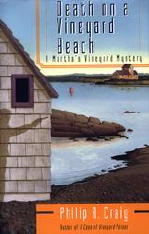
Another excerpt, this one taken from Death on a Vineyard Beach:
Zee and I got married at noon on July 13, a date artfully chosen by me in the hope that since it was my birthday, one of the four dates I usually remembered — the Others being New Year’s Day, Christmas, and the Fourth of July — I had a fighting chance of recollecting my anniversary in the future.
It was a beautiful Martha’s Vineyard day, with a warm sun in a cloudless sky, and a gentle north wind to keep things comfortable for all of us who had abandoned our summer shorts and had dressed up for the occasion. There were people with regular cameras and video cameras moving around shooting pictures. Apparently we were going to get the whole thing on record.
In this excerpt from A Deadly Vineyard Holiday, J. W. has just met a young girl on the beach:
There was an odd combination of sophistication and innocence about the girl, and, being just about old enough to be her father, I tried to imagine what it would be like to watch other people fish and not know how to do it myself. But I had been fishing as long as I could remember, thanks to my own father, who had gotten a rod into my hands before I could read.
“You want to give it a try?” I asked.
Her eyes widened. “Yes!”
I got my spare rod off the roof rack and put a Ballistic Missile on the leader.
“This is a good casting plug,” I said. “And the bluefish love it.”
We went down to the water, and I showed her how to throw the bail on her reel, to hook the line on her trigger finger, to take the rod straight back, and to bring it straight forward, releasing the line at about a 45-degree angle to the horizon.
Then I made a couple of casts, showing her how it was done, and gave her the rod.
“Don’t try to cast too far, at first. Just concentrate on throwing straight out. And don’t worry about making mistakes. Everybody makes them.”
“Okay.” She threw the bail, hooked the line with her finger, and took the rod back. Her first cast went into the surf right at her feet.
The Books. Adapted from Crime Fiction IV, by Allen J. Hubin, and from Mr. Craig’s own website:
CRAIG, PHILIP R. (1933- 2007)
* Gate of Ivory, Gate of Horn (n.) Doubleday 1969 [Sweden]
* A Beautiful Place to Die (n.) Scribner 1989 [J. W. Jackson; Martha’s Vineyard]
* The Woman Who Walked Into the Sea (n.) Scribner 1991 [J. W. Jackson; Martha’s Vineyard]
* The Double-Minded Men (n.) Scribner 1992 [J. W. Jackson; Martha’s Vineyard]
* Cliff Hanger (n.) Scribner 1993 [J. W. Jackson; Martha’s Vineyard]
* Off Season (n.) Scribner 1994 [J. W. Jackson; Martha’s Vineyard]
* A Case of Vineyard Poison (n.) Simon 1995 [J. W. Jackson; Martha’s Vineyard]
* Death on a Vineyard Beach (n.) Scribner 1996 [J. W. Jackson; Martha’s Vineyard]
* A Deadly Vineyard Holiday (n.) Scribner 1997 [J. W. Jackson; Martha’s Vineyard]
* A Shoot on Martha’s Vineyard (n.) Scribner 1998 [J. W. Jackson; Martha’s Vineyard]
* A Fatal Vineyard Season (n.) Scribner 1999 [J. W. Jackson; Martha’s Vineyard]
* Vineyard Blues (n.) Scribner 2000 [J. W. Jackson; Martha’s Vineyard]
* Vineyard Shadows (n.) Scriber 2001 [J. W. Jackson; Martha’s Vineyard]
* Vineyard Enigma (n.) Scribner 2002 [J. W. Jackson; Martha’s Vineyard]
* A Vineyard Killing (n.) Scribner 2003 [J. W. Jackson; Martha’s Vineyard]
* Murder at a Vineyard Mansion (n.) Scribner 2004 [J. W. Jackson; Martha’s Vineyard]
* Vineyard Prey (n.) Scribner 2005 [J. W. Jackson; Martha’s Vineyard]
* Death in Vineyard Sand (n.) Scribner 2006 [J. W. Jackson; Martha’s Vineyard]
* Death in Vineyard Waters (n.) Avon 2003; originally published as The Woman Who Walked Into the Sea (Scribner, 1991).
* Vineyard Deceit (n.) Avon, 2004; originally published as The Double-Minded Men (Scribner, 1992)
* Vineyard Fear (n.) Avon, 2004; originally published as Cliff Hanger (Scribner, 1993)
… with WILLIAM G. TAPPLY
* First Light (n.) Scribner, 2001 [J. W. Jackson & Brady Coyne; Martha’s Vineyard]
* Second Sight (n.) Scribner 2005 [J. W. Jackson & Brady Coyne; Martha’s Vineyard]
* Third Strike (n.) Scribner 2007 [J. W. Jackson & Brady Coyne]
Brady Coyne is a Boston attorney who has had numerous cases to solve on his own. Both the authors and their characters, as it turns out, are old fishing buddies, and it came as no surprise when readers found them respectively writing and solving murders together.
Plus:
Delish: The J.W. Jackson Recipes, co-written with Shirley Prada Craig (Vineyard Stories, 2006)
[UPDATE] Later the same day. A lengthy personal tribute by Bill Tapply to his friend and collaborator, Philip R. Craig, is online here.
Tue 8 May 2007
Posted by Steve under
AuthorsNo Comments
On the Matter of Robert Edmond Alter
by Victor A. Berch
When Steve Lewis posted an article by Peter Enfantino on Robert Edmond Alter’s contributions to Alfred Hitchcock’s Mystery Magazine with a bibliography of Alter’s writings by Peter Enfantino, Steve and myself, I was hardly concerned with the man. I just took it for granted that the biographical dictionaries had covered his vital statistics.
Then, a few weeks ago, Steve received an e-mail from Tom Grueter saying that he was going to forward a list of Alter’s publications which Alter’s agent, Larry Sternig, had put together for him some years ago. It was soon after the bibliography arrived that I decided to look into Alter’s background. I looked at his entry in Contemporary Authors and took note that his parents were listed as Retla Alter and Irene (Kerr) Alter.
The entry went on to say that Robert Edmond Alter was born in San Francisco on December 10, 1925. Therefore he should show up in the 1930 US Census record.
Much to my chagrin, no record of Robert Edmond Alter nor any variation thereof (such as Robert E. Alter, R.E. Alter, Robert Alter, R. Alter) with that birth date materialized. This was quite puzzling. Perhaps, I thought, it would be easier to track down his parents in 1930. And I proceeded to do so.
Well, one can imagine my surprise when the census entry showed Retla Alter as head of the household, Irene Alter as his wife, and Robert Pedroni as his stepson.
One of the features of the 1930 US Census to be recorded by the census taker was information on how old each married person had been at the time of their first marriage. Upon examination of the record, it showed that Retla Alter had been 34 years old, which meant that he had been born sometime in 1896, and that he had been first married at age 34, and that meant that he had just been married.
Irene Alter’s record showed that she was 27 years old, which meant that she was born in 1903 or thereabouts and that she had been 24 years old at the time of her first marriage. Robert Pedroni’s age was given as 4 years and 4 months old. The date that the census was taken was April 13, 1930 , which would place Robert Pedroni’s birth date in December of 1925, exactly the time that Robert Alter’s birth date is recorded.
It was then that I decided to see whether there were any death records for the Alter family. Had any of them passed away before the Social Security Death Index could reveal any information?
Well, two records were found in the SSDI: that of Robert Alter’s mother and that of Robert himself (although not yet 65 at the time of his death, someone had claimed his death benefit.). But my subscription to Ancestry.com provided me with access to the California Death Index, 1940-1997, where all three records for the Alter family were found. Moreover, my subscription included access to the California Birth Index, 1905-1995.
For Retla Alter, his death record revealed that he had been born Jan. 7, 1896 in Pennsylvania, had died in Los Angeles, CA July 29, 1945 and that his mother’s maiden name had been Darn (a little research on my part found this to be a mistranscription of some sort, as the actual name was Dorn).
For Irene Alter, it stated that Irene Mary Alter had been born June 5, 1895 in California and died March 10, 1984 in Los Angeles, CA and that her mother’s maiden name had been Flanneley and her father’s surname had been Kerr (surprise! she was actually older than Retla by a half year. Oh! Did I mention that the census was taken by one, Effie Kerr? Could there have been a wink-wink when it came to giving the census taker her age? Possibly).
As for Robert Edmond Alter, the California Death Index showed that he was born December 10, 1925 in California. Died May 26, 1966 in Los Angeles, CA and his mother’s maiden name was Kerr. All of which conformed to the entry in Contemporary Authors.
My final search would be for the birth record of a Robert Pedroni which would match the record of Robert Edmond Alter. No matter what I tried, nothing materialized. Yet, there was a birth record for Robert Edmond Alter. He was born December 10, 1925 in San Francisco county, and his mother’s maiden name was Kerr. How could that be? What happened to Robert Pedroni?
I decided to get the answer regarding step-children from my local City Clerk and the explanation was quite simple. Should a step-child be legally adopted, the birth record is amended to reflect the family name of the adopting parent. So, at some point after 1930, it can safely be assumed that Robert Pedroni was legally adopted by Retla Alter and took on his stepfather’s family name.
Yet, I have that nagging feeling that I would like to know who had been Robert Edmond Alter’s birth-father. Maybe Robert had that feeling at some point in his life. Perhaps, one day Ancestry.com will have a database of California Marriage Records.
Mon 7 May 2007
MICHAEL KURLAND – The Empress of India
St. Martin’s Minotaur; hardcover. First Edition: February 2006.
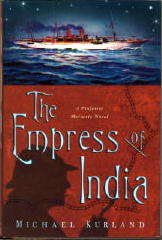
On and off over the period of nearly 30 years, Kurland has been chronicling the adventures of Sherlock Holmes’ most notorious nemesis, James Moriarty. In the process his primary intents seems to have been to clean some of the tarnish off the good (or not so good) professor’s reputation.
Not that Holmes was entirely mistaken about him, but could it just possibly be that Moriarty was NOT responsible for all of the crimes Holmes suspected him of committing?
Take this latest case, for example. When a fortune in gold is known to be on its way to the Bank of England from India, and Moriarty is known to be on the way to Calcutta, what other reason could he have other than the most obvious one? Wrong. Admittedly he has nefarious intent, but the gold is not why he is there.
While Holmes himself has mysteriously disappeared, swept away in a London sewer, Thuggees seem to have re-emerged as an evil force in India, and Dr. Pin Dok Low and his gang of unsavory associates really do have gold on their minds.
While Kurland is not terribly convincing when writing in the mode of Doyle, when he is left to tell his own rollicking story, what a glorious romp of a tale it is! His quick breezy style, interspersed with small jabs of wry humor, makes this particular caper move along in fine smile-provoking fashion.
That there is also a locked room mystery to be solved is only the frosting on the cake.
FOLLOWUP: Rather than expand upon my (of necessity) shorter than usual review, which first appeared in the Historical Novels Review, I’ve decided to take a look instead at the complete list of Michael Kurland’s mystery and detective fiction, as much (as always) for my own benefit as yours, as many of these books I’d never been fully aware of until now.
I’ll be working in somewhat chronological order, but also grouping the novels by theme and series character, with some comments or two scattered between. Not included are Kurland’s science fiction and fantasy novels with no criminous connection, but perhaps The Unicorn Girl (Pyramid, pbo, 1974) deserves a mention, as it partially takes place in the same alternative universe as Lord Darcy, about whom, keep reading.
+++++
Mission: Third Force. Pyramid R-1578, pbo, 1967.
Mission: Tank War. Pyramid X-1876, pbo, 1968.
Mission: Police Action. Pyramid, pbo, 1969. [Scarce. No copies on ABE. It is quite possible that the book was never published.] [UPDATE: This is correct. According to Mr. Kurland, the book became A Plague of Spies instead.]
I have a copy of the second of these, but as usual, I don’t have it at hand and available for inspection. Here is a description taken from an online listing, however, one that will give you the essence of what kind of spy thrillers all three books are likely to be:
“Are you a little country with BIG trouble? WAR, Inc. will – develop your weapons – train your troops – plan your strategy – and even fight your wars! Peter Carthage of WAR, Inc. races to Asia on a crash-priority mission – find a way to stop a guerrilla army terrorizing a tiny, independent kingdom. But there’s a joker in the contract – a hidden party to the conflict – and Carthage and his WAR, Inc. team are in the fight of their lives against the mysterious, deadly Third Force.”
It is not known if Peter Carthage, the “Man from WAR” is in either of the other two books or not. If he is, he is a series character not (yet) known to Al Hubin. [UPDATE: Peter Carthage is indeed in all three books, the third being the one below.]
A Plague of Spies. Pyramid X2098, pbo, 1969. [Finalist for Edgar award.]
Described by one bookseller as a “sexy spy thriller.”
+++++
The Professor Moriarty / Sherlock Holmes novels:
The Infernal Device. Signet J8492, pbo, January 1979. [Finalist for an Edgar and nominated for an American Book Award.]
Death by Gaslight. Signet AE1915, pbo, December 1982.
The Great Game. St. Martin’s, hc, August 2001.
St. Martin’s, trade pb, February 2003.
Publisher’s info on the latter:
“In March 1891, an unknown caller arrives at Moriarty’s door on a matter of great urgency. But before Moriarty can be summoned to speak with him, he is shot by a crossbow bolt loosed by unseen hands. While a lesser man might be daunted, Moriarty is merely intrigued and begins to investigate. What Moriarty discovers is that a cabal is attempting to use assassination to destablize the rule of the crowned heads of Europe. But he also senses that there is more than this operating — a conspiracy within a conspiracy — and detects the workings of a mind possibly more clever than his own. Using his agents around the world, Moriarty must outwit his most clever opponent ever while the fate of the world hangs in the balance.”
The Infernal Device and Others. St. Martin’s, trade pb, August 2001.
Publisher’s info on the contents:
The Infernal Device – A dangerous adversary seeking to topple the British monarchy places Moriarty in mortal jeopardy, forcing him to collaborate with his nemesis Sherlock Holmes.
Death by Gaslight – A serial killer is stalking the cream of England’s aristocracy, baffling both the police and Sherlock Holmes and leaving the powers in charge to play one last desperate card: Professor Moriarty.
“The Paradol Paradox” – The first new Moriarty story in almost twenty years, it has never before appeared in print.
The Empress of India. St. Martin’s, hc, February 2006.
+++++
The Last President, with S. W. Barton. William Morrow, hc, 1980.
Critics Choice Paperbacks/Lorevan Publishing, pb, June 1988.
+++++
Psi Hunt. Berkley 04664, pbo, September 1980.
Star Griffin. Doubleday, hc, March 1987.
Science-fiction crime novels both, taking place in the future as constituted at the time of their writing.
+++++
Ten Little Wizards. Ace 80057, pbo, March 1988.
A Study in Sorcery. Ace 79092, pbo, May 1989.
The detective of record in both of these novels is Lord Darcy, a character created by SF author Randall Garrett. Darcy is a private security expert and chief investigator for Richard, Duke of Normandy, in an alternate world from ours in which magic takes the role of science. Garrett wrote one novel and several short stories about Lord Darcy, and after Garrett’s death, Kurland wrote the final two adventures.
+++++
Too Soon Dead. St. Martin’s Press, hc, March 1997.
The Girls in the High-Heeled Shoes. St. Martin’s Press, hc, August 1998
St. Martin’s Press, trade pb, August 2001.
A traditional mystery series set in New York City in 1935, featuring New York World columnist Alexander Brass.
+++++
And I’d certainly be remiss if I failed to include the Holmes-related anthologies edited by Kurland:
My Sherlock Holmes: Untold Stories of the Great Detective. St. Martin’s Press, hc, February 2003. Stories about Holmes but told by characters from the canon other than Dr. Watson.
St. Martin’s Minotaur, trade pb, November 2004.
Sherlock Holmes: The Hidden Years. St. Martin’s Minotaur, hc, November 2004. An anthology of original stories taking place while Holmes was believed dead after Reichenbach Falls.
St. Martin’s Griffin, trade pb, January 2006.
Sun 6 May 2007
FROM THE PREFACE —
In a previous volume, The Green Flag, I have assembled a number of my stories which deal with warfare or with sport. In the present collection those have been brought together which are concerned with the grotesque and with the terrible — such tales as might well be read “round the fire” upon a winter’s night. This would be my ideal atmosphere for such stories, if an author might choose his time and place as an artist does the light and hanging of his picture. However, if they have the good fortune to give pleasure to any one, at any time or place, their author will be very satisfied.
— Arthur Conan Doyle, Windlesham, Crowborough.
ARTHUR CONAN DOYLE – Round the Fire Stories
Smith, Elder, 1908, hc. Also published abridged as: Tales for a Winter’s Night. Academy Chicago (U.S.), 1989; Academy Chicago (England), 1990. According to Crime Fiction IV, by Allen J. Hubin, only some stories are criminous. Film (based on “The Lost Special”): Universal, 1932 (scw: Ella O’Neill, George Plympton, Basil Dickey, George Morgan; dir: Henry McRae)
None of the Round The Fire Stories features Mr. Sherlock Holmes, although two mention anonymous letters to the press presenting solutions which some readers believe to have penned by the great detective himself (“The Man With the Watches” and “The Lost Special”). FOOTNOTE.
In “The Man With The Watches” the titular corpse is found dead an hour into the London-Manchester rail journey. Three other passengers have disappeared yet none were seen to leave or join the train at the one stop made before the grisly discovery. Where are the missing trio and why is the dead man in possession of no less than six gold timepieces?
The village of Bishop’s Crossing is the home of Doctor Aloysius Lana, whose olive skin led to his nickname of “The Black Doctor.” After receiving a letter from abroad, Dr Lana breaks off his engagement to Miss Morton, whose enraged brother Andrew declares the doctor deserves a good thrashing. Dr Lana is subsequently discovered dead and the evidence points to Andrew being the guilty party. But was he?
Ward Mortimer is appointed curator of the Belmore Street Museum. Its greatest treasure is “The Jew’s Breastplate,” a gold artifact decorated with a number of valuable gems. Soon there are two burglaries, both of which focus on the breastplate. How is the miscreant getting in and why doesn’t the culprit just pinch the breastplate and be done with it?
Louis Caratal and his companion, newly arrived in Liverpool from central America, must get to Paris without delay. Caratal charters a train to London but “The Lost Special” disappears between St Helens and Manchester, the only trace of its passage being the dead body of its driver, found at the foot of an embankment. The truth comes out some time later, and even then it’s as the result of a confession rather than an investigation.
John Maple’s Uncle Stephen has one leg shorter than the other, so is known as “The Club-Footed Grocer” due to his high-soled boot, which regularises the length of the limb. One day John receives an urgent summons to his uncle, involving extremely odd instructions on how to reach his isolated dwelling. The mystery is slight, although the story has a touch of the Buchan about it.
“The Sealed Room” opens with solicitor Frank Alder’s accidental (literally) meeting with Felix Stanniford, son of a disgraced banker who fled the country some years previously and has not reappeared, despite a letter two years before strongly indicating he will return. Given the title, almost all readers will immediately guess what the mystery might be and they’d be right.
Lord Southerton’s nephew and presumptive heir to the family fortune is Marshall King, a spendthrift who devotes his time to frivoling about London. Marshall’s cousin Everard King has purchased an estate after returning from South America, bringing various wild life including “The Brazilian Cat” back with him. On the verge of bankruptcy, Marshall accepts an invitation to visit Everard. This story is not a mystery as such and while the plotline is predictable, there are moments of genuine excitement.
It’s back to more traditional crime in “B. 24.” The narrator presents a plea for clemency, in which he admits to burglarising a country mansion, but adamantly denies killing its owner, Lord Mannering, and instead points the finger at Lady Mannering, who hates her husband and according to local gossip has reason to feel that way. B. 24 asks that her background be investigated before he is executed. Is he innocent or trying to save his neck at the expense of hers?
My verdict: An uneven collection, although an interesting hour or two will be spent reading it. Most readers will guess the solutions but one or two twists may be more difficult to rumble and it was a refreshing change from Holmes and company taking centre stage.
FOOTNOTE: I must thank various members of the Golden Age of Detection Yahoo group for their further discussion of this point.
In “The Man With The Watches” we see: “There was a letter in the Daily Gazette, over the signature of a well-known criminal investigator…”
… and then we have “The Lost Special,” in which we learn of a letter: “… which appeared in the Times, over the signature of an amateur reasoner of some celebrity at that date, attempted to deal with the matter in a critical and semi-scientific manner. An extract must suffice, although the curious can see the whole letter in the issue of the 3rd of July.
“‘It is one of the elementary principles of practical reasoning,’ he remarked, “that when the impossible has been eliminated the residuum, however improbable, must contain the truth….”
And I think we’ll agree the second letter in particular has his grammatical fingerprints all over it, but it raises another question: why didn’t Conan Doyle write these two adventures as Holmes stories? Were these stories written during a period when he was thoroughly tired of his own creation?
Etext: http://gutenberg.net.au/ebooks06/0600401.txt
[Note: This online version does not include all of the stories in the original edition. See below.]
Complete contents, as taken from CFIV:
# • B.24 [“The Story of the B24”] • ss The Strand Mar, 1899
# • The Beetle Hunter [“The Story of the Beetle Hunter”] • ss The Strand Jun, 1898
# • The Black Doctor [“The Story of the Black Doctor”] • ss The Strand Oct, 1898
# • The Brazilian Cat [“The Story of the Brazilian Cat”] • ss The Strand Dec, 1898
# • The Brown Hand [“The Story of the Brown Hand”] • ss The Strand May, 1899
# • The Club-Footed Grocer [“The Story of the Club-Footed Grocer”] • ss The Strand Nov, 1898
# • The Fiend of the Cooperage • ss The Manchester Weekly Times Oct 1, 1897
# • The Japanned Box [“The Story of the Japanned Box”] • ss The Strand Jan, 1899
# • Jelland’s Voyage • ss
# • The Jew’s Breastplate [“The Story of the Jew’s Breastplate”] • ss The Strand Feb, 1899
# • The Leather Funnel • ss McClure’s Nov 1902
# • The Lost Special [“The Story of the Lost Special”] • ss The Strand Aug, 1898
# • The Man with the Watches [“The Story of the Man with the Watches”] • ss The Strand Jul, 1898
# • Playing with Fire • ss The Strand Mar 1900
# • The Pot of Caviare • ss The Strand Mar 1908
# • The Sealed Room [“The Story of the Sealed Room”] • ss The Strand Sep, 1898
# • The Usher of Lea House School • ss The Strand Apr, 1899
Sun 6 May 2007
Steve,
Thanks for a great tribute to Desmond Cory on your blog. It’s greatly appreciated by the Cory fan club members. I contacted some of them who run the [Desmond Cory] website you mention, asking if there are any aspects of his life left out.
Well, although not really dramatic, below are some points not mentioned that you might want to consider:
CHILDREN’S NOVELS:
Cory wrote a number of novels for children. I am aware of at least:
1958. Ann & Peter in Southern Spain (The Kennedys Abroad). Paperback: Frederick Muller Ltd., London, using pen-name Theo Callas.
1960. Jones On The Belgrade Express: An Adventure Story For Boys. Hardcover & jacket: Frederick Muller Ltd., London; First Edition. The adventures of Jones in Macedonia; an irrepressible schoolboy. Used Desmond Cory pen-name.
SHORT STORIES:
Cory wrote quite a few short stories too. Below is a sample:
1975. “The Crime of Prince Milo.” Appeared in Winter’s Crimes 7; Macmillan: London; edited by Hardinge.
1976. “Story of Stumblebum, the Wizard.” Appeared in Winter’s Crimes 8; Macmillan: London; humorous detective story featuring the inane wizard, StumbleBum.
1980. “Song of Fariq.” Appeared in The Mystery Guild Anthology, edited by John Waite; Constable: London
1992. “Switchblade.” Appeared in Midwinter Mysteries #2; Little Brown & Co: London; Short story featuring Professor Dobie.
RADIO PLAYS:
1956. “The Secret Metal,” by Norman Edwards — freely adapted from Desmond Cory’s The Phoenix Sings (1956).
1959, Oct 31. “Shaken Leaf.” BBC Radio Play produced by R.D. Smith — adapted by Daphne Laney from the novel by Desmond Cory
1960, March 26 9.15 pm. “Pilgrim at the Gate.” BBC Radio Play adapted by Norman Edwards
Unconfirmed date. “The Phoenix Sings.” BBC Radio Play
1961. “Orbit One,” based on novel High Requiem.
CINEMA:
1958. The Mark of the Phoenix. Directed by Maclean Rogers, 1958, written by Norman Hudis; based on Cory’s novel The Phoenix Sings.
1972. England Made Me. Screenplay of Graham Green’s novel.
ACADEMIC BOOKS & ARTICLES:
Probably one of Cory’s best kept secrets was that he was a university professor of English. His academic works varied a great deal. Below is an inkling of his work here:
1977. “Language and Behaviour.” Article Incorporated Linguist
1980. “Modes of Comedy.” Hardcover (no jacket); Volturna Press
1981. “Antonio Machado and the Cycle of Life.” Article Bulletin Hispanic Studies
1981. “English Literature and its Backgrounds.” Paperback (thick edition) Routledge
1983. “Eliot’s ‘mythical method’ and the poetic image.” Article Comparative Literature Studies
1983. “Hemingway and the Pardoner’s Tale.” Article American Literature
My thanks again for the blog entry.
— Best wishes, Jan
Sat 5 May 2007
A couple of months ago I reviewed a book by Marguerite Silverman entitled The Vet It Was That Died. I didn’t include any biographical information on the author because at the time, I couldn’t find any. Nor was there anything more about her in Crime Fiction IV, by Allen J. Hubin, only the following list of the three books she wrote:
SILVERMAN, MARGUERITE R(uth)
* The Vet It Was That Died (n.) Nicholson 1945 [Chief Insp. Christopher Adrian; England]
* Who Should Have Died? (n.) Nicholson 1948 [Chief Insp. Christopher Adrian; England]
* 9 Had No Alibi (n.) Nicholson 1951 [Chief Insp. Christopher Adrian; England]
For my overall opinion of the book, you can read the review. Here?s a quote, though, from somewhere early on:
… The primary detective in each is Chief Inspector Christopher Adrian. Coming to his assistance in this one, at least, a relatively minor affair, is a newly graduated veterinarian surgeon by the name of Helena Goodwin.
Helena’s involvement with the mystery is due only to this, her first job, however, and in fact she’s one of those immediately on the scene when her body of her veterinarian employer is found.
Keep this in mind, as this will be important later. I no longer remember the reason — and this was only yesterday, mind you — but I happened to Google the author’s name, and up came up several websites I hadn’t seen before. Marguerite Silverman is not a common name, but neither is it uncommon, which makes a big difference when trying to locate an author when all you have to work with is her or her name.
But one or two of these websites mentioned Marguerite Silverman as being — a veterinarian! And yet another site where I found her name was in relation to pets and their well-being.
I asked British librarian-sleuth John Herrington if I was onto something, and indeed, yes he agreed, sending me this paragraph about her, found here:
Marguerite R Silverman, MRCVS, ACIS, graduated from the Royal Veterinary College in 1935 and spent some time in companion animal practice before the Second World War. She then changed career and developed a successful business in verbatim recording (before the invention of the tape recorder). In 1958, following a holiday visit to Israel during which she had been distressed by the scale of the animal suffering she had seen, she founded the Society for Animal Welfare in Israel. […] In 1986 she approached UFAW about the possibility of SAWI being taken under its wing […] She died peacefully at a nursing home, near her home in Catcott in Somerset, on Friday 5 December 2003, aged 89.
For those of us who are acronym-disabled, Google helps out in this manner also:
MRCVS = Member of the Royal College of Veterinary Surgeon
ACIS = Associate of the Chartered Institute of Secretaries
UFAW = Universities Federation for Animal Welfare
Working backward from her age at the time she died, along with the fact that she passed away so late in the year, it means that Miss Silverman, who apparently never married, was born in 1914. Unfortunately the Somerset Local Studied Library had no obituary on record for her. Then in a later email, John reported that: “According to Freebmd, her birth was registered in Southampton in June 1914. (Entry is incorrect as transcriber has read the R for Ruth as an M — magnification of the entry shows it as a poor R.)”
I’ve still read only the one book of the three that Marguerite Silverman wrote. Knowing that she was a veterinarian herself, and learning of her lifelong love of animals, puts the book into a perspective I hadn’t had before. It also puts tracking down her other two mysteries several notches higher on my scale of things to do. Both are rather scarce, unfortunately.
—
[UPDATE] 05-07-07. Although neither John nor I realized it, Al Hubin already had the information on Miss Silverman’s birth and death dates. See his Addenda #9 for the Revised CFIV.
Sat 5 May 2007
HUNTER STINSON – Fingerprints
Henry Holt & Co.; First Edition, March 1925.
After a short investigation on my part, I believe that I can safely say that this is the only edition that was published of this book, nor were there any other books that appear under this author’s name. (The asking price for the only copy found on the Internet at the time I am writing this is $50, but that is certainly explainable by the fact that that particular copy is inscribed by the author; otherwise it is in about the same condition as mine.) FOOTNOTE.
Long time readers of the pulp magazines may, however, suspect that they know the author by a slightly different name, and they would be correct, if they happen to be thinking of H. H. Stinson. An incomplete list of his short fiction at Bill Contento’s Fiction Mag website begins with a western story published in Top Notch in 1928 and ends with a mystery yarn in Black Mask in 1948. In the latter magazine he had a series character by the name of Kenny O’Hara.
To discover more, I put out a call for help, first from Victor Berch, whose name has been mentioned on these pages before, then from the various members of the Pulp Mags yahoo list:
[From Victor:] I think I found your man. He’s Herbert H. Stinson. In the 1930 Census he’s listed as a police reporter. In the 1920 Census, he’s listed as a journalist. Have his birth and death dates: Born 27 Apr 1896, Died 09 Oct 1969. Mother’s maiden name was Hunter, so that would fit right in. Wrote some plays as well out in California.
[From John Locke:] He’s mentioned in The Black Mask Boys [edited by William F. Nolan]:
The following year [1933] proved to be Shaw’s finest as he brought five powerful new writers into the Mask: Thomas Walsh, Roger Torrey, H. H. Stinson, W. T. Ballard, and (at the close of 1933) Raymond Chandler.
H.H. Stinson’s series hero was quick-fisted Ken O’Hara, of the Los Angeles Tribune. Again, a very tough cookie.
From the AFG Bulletin, July 1, 1936:
Joseph T. Shaw,
Black Mask:
Your request to select a “model” story in the July Black Mask, or in almost any issue, for that matter, cannot be fairly done without a word of explanation. You see, we follow the principle of “no dud in any issue;” therefore it is rarely that any one story stands out markedly from any other or all of the balance, although we hope that the magazine itself, as a whole, does.
So far as the writers permit, we select for an issue the best of as many types as are available; in consequence, readers naturally have preference for one over another in accordance with their individual tastes, and all may be equally good as to workmanship quality. There is a story in the July issue, however, which can be pointed to for a specific reason. It is “Nothing Personal,” by H. H. Stinson.
If a new writer should ask me to suggest what might be interesting to our readers, I would probably mention anything but what Mr. Stinson has in his story, in the way of characters, by name or position – that is, a reporter, an editor, a tough police official, and so on. They have been used so many, many times.
Yet Mr. Stinson has done something with these familiar identities, with the ordinary action, which, to many readers, will make this an outstanding, a “model” story, in any company. The one word to describe it is “treatment.” He has brought every one of his characters vitally alive. The fact that they are this, that or the other is less important than that they are “real” personages; not once do they speak, act or react out of character – with a more or less commonplace setup, his handling of story detail, of constant menace, of action, is masterly. One careful reader refers to one of his scenes as the most vivid, the best of its type since Hammett told about Ned Beaumont in The Glass Key.
The fact that Mr. Stinson is himself a newspaper man, a police reporter on one of the big Los Angeles papers, may have contributed to the sense of reality which he has infused into the story. But it isn’t every newspaperman who can make a story live and throb like this one. If it were, editors would have an easier time.
A “model” story. No – except for treatment. A marvelously entertaining and vital one? Yes – decidedly yes.
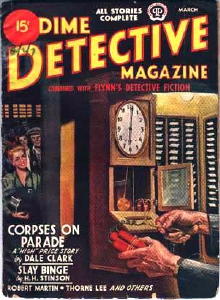
[From Ed Hulse:] Besides O’Hara in Black Mask, Stinson in the post-WWII years wrote a series about a dick named Pete Rousseau for Dime Detective.
He stopped writing for both Mask and Detective in 1948. He wrote for other detective pulps, too; Cook-Miller credits him with 60-odd stories altogether.
[From Will Murray:] I just went through my copy of the manuscript of the Joe Shaw bio written by his son, Milton. I find no mention of HHS.
However, Shaw did pick one Stinson story for possible inclusion in his Hard-Boiled Omnibus, “Give a Man Rope.” His editor thought it weak in comparison to other selections and it was dropped along with several others.
So we know what Shaw thought was his best BM story.
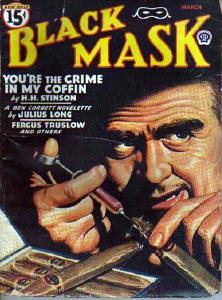
Me again. I’m back, and I’m assuming that after all of this talking, as interesting as I hope you found it, you’d like to hear about the book itself. Truth be told, it’s not very good, but for most of an evening or two, the entertainment value is still high enough that I did. Read it in an evening or two, that is.
As the story begins, the primary protagonist has discovered that as of that very same morning, he is a pauper. The estate he believed that had been left to him by his overly generous father, he learned, had been badly (and sadly) overtaken by various notes, mortgages, liens and debts. Which therefore means, as of that very same evening, his marriage to Maryse Douglas is off.
Not by any wishes of the young lady herself, far from it, but by Owen Kenrick, her guardian until she comes of age. Here is how the author describes the young lady, on page 5:
…Though Maryse Douglas had only the standard equipment of eyes, mouth, hair and other features with which any member of the race goes through life, the component parts seemed to have been arranged in such wise that most young men upon seeing her went away mumbling to themselves of resolves to lead better lives and some day be worthy of her.
The next morning Christopher is consoled by a gent by the name of Bosworth, who lives in the apartment upstairs from him. From page 13:
“Cheerio, lad. Into every life a couple of showers have to fall, as some ass of a poet remarked. No doubt in the least that you’ll get on.” He proceeded cautiously as became a venture on delicate ground. “And if I can help, old onion, you’ll make me thoroughly irritable by not letting me come to the fore.”
This is not the sort of dialogue that would make any kind of headway in the pages of either Black Mask or Dime Detective, nor would the mystery itself. When Kenrick is found dead, young Christopher is, of course, the obvious suspect. The only others in the running are the butler or Miss Douglas herself, and when Christopher’s fingerprints are found on the murder weapon, that just about clinches the case right then and here.
Except for one undeniable fact, and that is that Christopher did not do it, and in the remaining 200 pages, it is up to him, Maryse, and Bosworth (who has secrets of his own) to prove it.
Also on Blake’s trail are a gang of jewel thieves (jewelry being a primary item of trade for the dead man) who kidnap Maryse as part of their nefarious doings, but she escapes and makes her way back to the city just as Blake and Bosworth discover the hideout where she had been kept a captive, and mystery upon mystery ensues. By page 209 Maryse has been captured again, by yet a third party to the drama, and rest of the book is devoted to her rescue, nothing more, and quite a lot less.
A lot happens in this book, as you can tell, but when it comes down to it, as I’ve already implied, nothing really happens, if you know what I mean. And what about the phony fingerprints? You might ask, and rightly so. In 1925, they were still a novelty to mystery readers, and so in 1925 they must have been amazed as to what could be done with them, by both the investigators and (in this case) the villains. I checked online with Google, and guess what, what the chaps on the wrong side of the law did back then could really be done. Of course Mr. Stinson makes it sound easy, but in terms of the technology of 1925, I’m still not quite convinced it would have been as easy as he made it sound.
FOOTNOTE: I seem to have spoken somewhat ahead of myself. After some further investigation I have discovered that the novel was previously published as a three-part serial in the mystery fiction magazine Real Detective Tales and Mystery Stories, concluding in the February 1925 issue. Mostly, I think but am not sure, the stories that appeared in RDT&MS were either of the mansion house variety or out-and-out thrillers, and thusly not hard-boiled fare at all.
Or am I making a judgment on a sample of size only one? Other authors who appeared in the magazine in 1925 include Seabury Quinn, Arthur J. Burks, Raoul Whitfield, Otis Adelbert Kline and Vincent Starrett. You tell me.
« Previous Page — Next Page »
